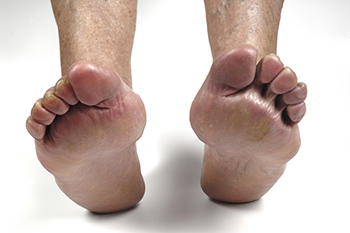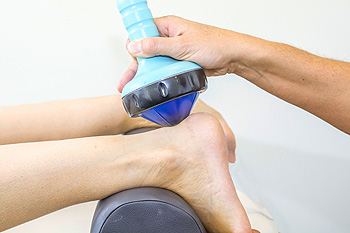Connect With Us
Blog
Items filtered by date: September 2023
Extensor Tendonitis

Extensor tendonitis in the feet can occur due to overuse, resulting in pain and discomfort. Extensor tendons play crucial roles in the movement of toes but are vulnerable to injuries. Foot extensor tendonitis typically presents as pain on the top of the foot, often affecting one foot more than the other. It can weaken the tendons, affecting toe movement and push-off ability. Common causes of this condition include wearing tight shoes and running excessively. Diagnosis involves having physical exams and, in some cases, imaging tests such as X-rays, ultrasounds, or an MRI. Treatment includes rest, stretching, and strengthening exercises. Steroid injections may be necessary for severe cases, with surgery reserved for rare instances. Recovery times can vary. Proper care and prevention can effectively manage extensor tendonitis, allowing a return to regular activities. If you think you may have this affliction, it is suggested that you make an appointment with a podiatrist for a proper diagnosis and treatment.
Toe pain can disrupt your daily activities. If you have any concerns, contact one of our podiatrists of Crystal Lake Foot & Ankle Center. Our doctors can provide the care you need to keep you pain-free and on your feet.
What Causes Toe Pain?
Most severe toe pain is caused due to a sports injury, trauma from dropping something heavy on the toe, or bumping into something rigid. Other problems can develop over time for various reasons.
Toe pain can be caused by one or more ailments. The most common include:
- Trauma
- Sports injury
- Wearing shoes that are too tight
- Arthritis
- Gout
- Corns and calluses
- Hammertoe
- Bunions
- Blisters
- Ingrown toenails
- Sprains
- Fractures (broken bones)
- Dislocations
When to See a Podiatrist
- Severe pain
- Persistent pain that lasts more than a week
- Signs of infection
- Continued swelling
- Pain that prevents walking
Diagnosis
In many cases the cause of toe pain is obvious, but in others, a podiatrist may want to use more advanced methods to determine the problem. These can range from simple visual inspections and sensation tests to X-rays and MRI scans. Prior medical history, family medical history, and any recent physical traumatic events will all be taken into consideration for a proper diagnosis.
Treatment
Treatments for toe pain and injuries vary and may include shoe inserts, padding, taping, medicines, injections, and in some cases, surgery. If you believe that you have broken a toe, please see a podiatrist as soon as possible.
If you have any questions please feel free to contact our office located in Crystal Lake, IL . We offer the newest diagnostic tools and technology to treat your foot and ankle needs.
Ways Arthritis Affects the Toes

Arthritis is an inflammatory condition that can have a profound impact on joints in the body, including the toes. The two forms of arthritis that affect the toes are osteoarthritis and rheumatoid arthritis. Osteoarthritis is often a result of wear and tear on the joints, where the protective cartilage at the ends of bones gradually deteriorates. When this occurs in the toes, it can lead to pain, stiffness, and a reduced range of motion. Walking and performing everyday tasks can become difficult. In contrast, rheumatoid arthritis is an autoimmune disorder in which the immune system mistakenly attacks the joints, including those in the toes. This autoimmune response triggers inflammation and swelling, and can even lead to deformities in the affected toes. Over time, the toe joints may suffer significant damage, further diminishing their functionality. This may cause chronic pain and mobility issues that can affect overall foot health. Basic activities such as walking, standing, or even wearing certain types of shoes can become challenging and painful. To address these issues effectively, it's suggested that you make an appointment with a podiatrist. This foot doctor can provide an accurate diagnosis, create a personalized treatment plan, and offer advice on managing symptoms.
Arthritis can be a difficult condition to live with. If you are seeking treatment, contact one of our podiatrists from Crystal Lake Foot & Ankle Center. Our doctors can provide the care you need to keep you pain-free and on your feet.
Arthritic Foot Care
Arthritis is a joint disorder that involves the inflammation of different joints in your body, such as those in your feet. Arthritis is often caused by a degenerative joint disease and causes mild to severe pain in all affected areas. In addition to this, swelling and stiffness in the affected joints can also be a common symptom of arthritis.
In many cases, wearing ill-fitting shoes can worsen the effects and pain of arthritis. Wearing shoes that have a lower heel and extra room can help your feet feel more comfortable. In cases of rheumatoid arthritis, the arch in your foot may become problematic. Buying shoes with proper arch support that contour to your feet can help immensely.
Alleviating Arthritic Pain
- Exercises that stretch the foot can prevent further pain and injury and increase mobility
- Most of the pain can be alleviated with anti-inflammatory drugs, heat, and topical medications
- Massages can help temporarily alleviate pain.
It is best to see your doctor for the treatment that is right for your needs and symptoms. Conditions vary, and a podiatrist can help you determine the right method of care for your feet.
If you have any questions, please feel free to contact our office located in Crystal Lake, IL . We offer the newest diagnostic tools and technology to treat your foot and ankle needs.
Shockwave Therapy as an Alternative to Foot Surgery

Shockwave therapy is a potential treatment for chronic foot pain problems, including plantar fasciitis and calcific tendonitis. It uses shockwaves delivered to the body to stimulate healing in affected tissues. There are high-energy and low-energy forms of this therapy. Low-energy shockwave treatment involves a series of sessions that are not very painful. In contrast, high-energy shockwave treatment is typically done in one session and can be quite painful, often requiring anesthesia. This therapy induces microtrauma to the affected tissue, triggering a healing response, increased blood vessel formation, and nutrient delivery to the area. It can relieve pain and promote tissue repair. Shockwave therapy is noninvasive, making it an attractive option for more challenging conditions. There are studies that support its effectiveness, particularly for calcific tendonitis and plantar fasciitis, with minimal reported complications. While more conservative measures may be tried first, it is considered a safe alternative to surgery for patients with chronic plantar fasciitis who have not responded to standard treatments. If you are at a point where more traditional treatments have not relieved pain from chronic foot conditions and surgery is being considered, it is suggested that you make an appointment with a podiatrist to discuss whether shockwave therapy might be a possible alternative for you.
Shockwave therapy is a treatment commonly used to treat various injuries and conditions, particularly plantar fasciitis in the feet. To learn more, consult with one of our podiatrists from Crystal Lake Foot & Ankle Center. Our doctors can provide the care you need to keep you pain-free and on your feet.
Shockwave Therapy
Shockwave therapy is a new treatment option designed to treat bone conditions such as tennis elbow, shoulder pain, and others. Shockwave therapy uses high intensity sound waves that are directed to the affected tissues of the body with pinpoint accuracy. The effects are very beneficial, leading to a production of collagen fibers, eliminating inflammation.
Who Benefits from Shockwave?
Shockwave is recommended for patients suffering from heel pain and associated problems. Heel pain is a common condition which can be caused by obesity, overexertion, and spending a substantial amount of time on hard floors with your feet exposed and unsupported.
Fast and Easy
The therapy is actually a simple process that can leave patients feeling better the very next day. Shockwave therapy is not as dramatic as it sounds. It enables more blood flow to effected areas, addressing the source of the problem and allowing treatment to last for a long time.
Treatment & Recovery Time
Shockwave treatment will enable your feet to recover quickly. This is especially important since surgery is not required. It is cost effective and does not require the use of anesthesia. This treatment is a better option to surgery, since it is proven safe.
If you have any questions, please feel free to contact our office located in Crystal Lake, IL . We offer the newest diagnostic and treatment technologies for all your foot and ankle needs.
